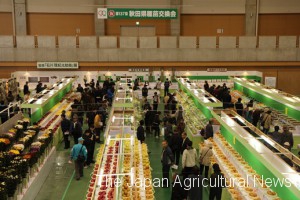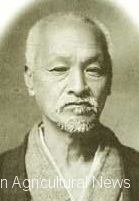Two headwaters to build rural villages
The mother of the current JA (Japanese nogyokyodokumiai (agricultural cooperatives)) was “nogyokai (agricultural institution)” that was combined sangyokumiai (cooperatives) and nokai (chamber of agriculture) during the war in 1943 (Showa 18). Because JA succeeded the character of cooperatives from sangyokumiai, generally the predecessor of the JA is said to be sangyokumiai.
On the other hands, JA also succeeded the farming guidance business and agricultural policy activities from “nokai (chamber of agriculture)” which merged with nogyokai (agricultural institution). (Tetsuro Shimizu, “History of Nokai system and farming guidance business by nogyokyodokumiai (agricultural cooperatives)”, from “Research and Information, January 2005” by Norinchukin research Institute).
It is necessary to disclose the history of nokai (chamber of agriculture) which is the other of the headwaters.
After the Meiji Restoration, Meiji government established the Ministry of Interior responsible for industrial promotion policy in 1873 (Meiji 6). The Ministry of Agriculture and Commerce, established in 1881 (Meiji 14), founded research and educational institutions of agriculture such as Naito Shinjuku Experiment Station (current Shinjuku Gyoen (Imperial garden), Tokyo), Mita Breeding station (in Shiba, Minato-ku, Tokyo), Sapporo Agricultural College (current Hokkaido University), and Komaba Agricultural College (current Faculty of Agriculture of Tokyo University). In order to focus on education, the Ministry also invited foreign teachers such as M. Fesca, O. Kellner, and W.S. Clark.
While progressing agricultural promotion policy by the government, since 1870’s the second half (Meiji 10’s), there were formed lots of exchange meeting of agricultural technology such as nodankai (agricultural meeting), kangyokai (agricultural promotion meeting), and shushikokankai (seedling exchange meeting).
The first nodankai (agricultural meeting) is said to be the meeting held by Terunori Furuhashi and his son Genrokuro Furuhashi, in Shitara County of Aichi Prefecture, in 1878 (Meiji 11). Then nodankai spread to Gunma prefecture, Fukushima Prefecture, and so on.

The 137th seedling exchange meeting, held in Oga city of Akita Prefecture in 2014 (provided by Chuokai (general association) of JA of Akita prefecture)
The seedling exchange meeting of Akita that also started in 1878 is even now continuing. The 138th meeting is planned to be held in Kazuno city from October 29 to November 4, 2015.
The government gradually began to review the conventional farming methods. In 1881 (Meiji 14), in conjunction with the second national industrial exposition, the government opened zenkoku nodankai (national agricultural meeting) inviting people called “rono (elderly experienced farmer).” Rono meant the leader having high agricultural technology by studying the conventional farming methods based on the agricultural manual and combining such methods with their own experience.
Especially, there were three farmers called “Three top rono of Meiji”, who were Denjibei Funatsu of Gunma Prefecture, Naozo Nakamura of Nara Prefecture, and Senji Nara of Kagawa prefecture. In addition, there were two famous farmers, who were Enri Hayashi of Fukuoka prefecture and Rikinosuke Ishikawa of Akita prefecture, founder of the seedling exchange meeting.
“Nokai (chamber of agriculture)” guided agricultural technology and policy
“Dainihon Nokai (Agricultural Society of Japan), the first nationwide central agricultural organization in Japan, was also founded in 1881. Yajiro Shinagawa, the Director-general of Agricultural Promotion Bureau of the Ministry of the Interior at that time, was appointed Secretary-General of it. Its business was limited to farming improvement, and Dainihon Nokai founded the agricultural patrol teacher’s system and agricultural fair, made efforts to spread agricultural technology by issuing its newsletter.
In 1891 (Meiji 24), Society of Agricultural Science showed the concept of the nokai (chamber of agriculture) system and claimed the necessity of the organization to control and guide whole rural area, in “Kono Ronsaku (theory & measures for agricultural promotion)”, which Tokiyoshi Yokoi, Professor of Tokyo Imperial University, was mainly writing.
In 1895 (Meiji 28), separated from the Dainihon nokai, Zenkoku nojikai (National Chamber of Farming) was founded as the national organization of local nokai (chamber of agriculture). Then, Masana Maeda, who became the secretary general of Dainihon nojikai, developed nokai system by his leadership respectively. In 1898 (Meiji 31), 41 fuken nokai (prefectural chamber of agriculture), 505-gun nokai (county chamber of agriculture), and 8806 cho-son nokai (towns and villages chamber of Agriculture) were established.
The previous year of enactment of sangyokumiai (cooperatives) law, nokai (chamber of agriculture) law was enacted. In 1910 (Meiji 43), Teikoku nokai (Imperial Chamber of Agriculture) (the first president was Hisayoshi Kano) was established and succeeded Zenkoku nojikai.
Thus, in the rural area, there were formed two of lineage organizations, “sangyokumiai (cooperatives)” responsible for the credit business and purchase & sales business, and “Nokai (chamber of agriculture)” responsible for agricultural policy activities and the dissemination of agricultural technology.


